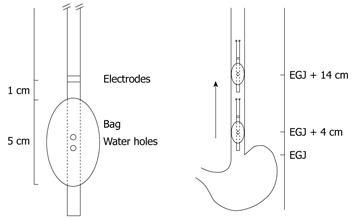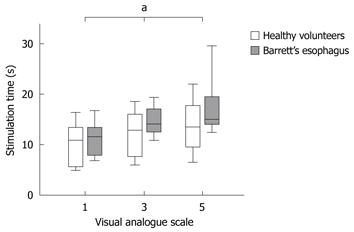Copyright
©2011 Baishideng Publishing Group Co.
World J Gastroenterol. Jan 28, 2011; 17(4): 514-521
Published online Jan 28, 2011. doi: 10.3748/wjg.v17.i4.514
Published online Jan 28, 2011. doi: 10.3748/wjg.v17.i4.514
Figure 1 Probe design and probe placement in the esophagus during the study.
After stimulation 4 cm above the esophago-gastric junction (EGJ) the probe was retracted 10 cm and the remaining protocol completed. Inlet and an outlet channels were used for circulation of water during mechanical and thermal stimulation. Electrodes were used for electrical stimulation (see text for details).
Figure 2 Schematic illustration of the stimulation protocol.
The following stimulations were applied in the metaplastic part 4 cm above the esophago-gastric junction: three mechanical preconditioning stimuli to the pain threshold [visual analogue scale (VAS) = 5]; mechanical stimulation to moderate pain (VAS = 7); thermal stimulation to the pain threshold; electrical stimulation to moderate pain; 50 electrical stimulations at the pain threshold were done to record evoked brain potentials. The mechanical, thermal and electrical stimulations were repeated 14 cm above the sphincter.
Figure 3 Mechanical stimulation evoking moderate pain in patients with Barrett’s esophagus and healthy volunteers.
Patients were hyposensitive to mechanical stimulation 4 cm above the esophago-gastric junction compared to healthy volunteers, P = 0.02. On the visual analogue scale, 1 = the sensation threshold, 3 = vague perception of moderate sensation, 5 = the pain threshold, and 7 = moderate pain. aP < 0.05.
Figure 4 Response to heat stimulation in patients with Barrett’s esophagus compared to healthy volunteers.
Patients were hyposensitive to heat stimulation 4 cm above the esophago-gastric junction (P = 0.04). On the visual analogue scale, 1 = the sensation threshold, 3 = vague perception of moderate sensation, 5 = the pain threshold. aP < 0.05.
Figure 5 Response to mechanical and thermal stimulations at maximum pain in patients with Barrett’s esophagus and healthy volunteers.
Patients were hyposensitive to mechanical and thermal stimuli 4 cm above the esophago-gastric junction (EGJ). Heat hyposensitivity were also found in the normal part of the esophagus 14 cm above the EGJ. Both patients and controls were less sensitive to mechanical stimulation 4 cm above the EGJ, whereas the sensitivity for heat was the same on the two levels. Numbers on the X-axis indicate the level of stimulations 4 and 14 cm above the EGJ. aP < 0.05.
- Citation: Krarup AL, Olesen SS, Funch-Jensen P, Gregersen H, Drewes AM. Proximal and distal esophageal sensitivity is decreased in patients with Barrett’s esophagus. World J Gastroenterol 2011; 17(4): 514-521
- URL: https://www.wjgnet.com/1007-9327/full/v17/i4/514.htm
- DOI: https://dx.doi.org/10.3748/wjg.v17.i4.514













